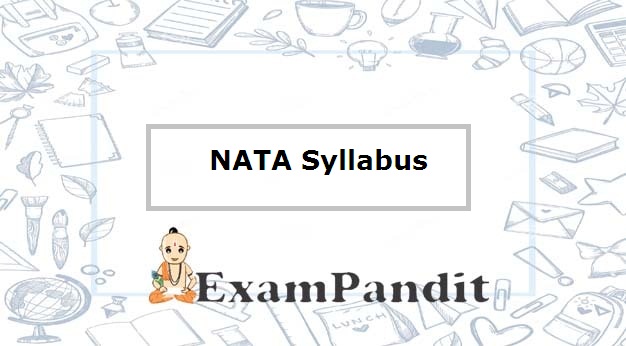Candidates appearing for NATA exam in the year 2022 should know its syllabus so as to prepare for the exam in advance. The NATA syllabus 2022 entails the topics candidates must study in order to score good marks in the exam. Through NATA, candidates can get admission in B.Arch program offered by the colleges across the country. To fetch good marks in the exam, it is important for the candidates to strictly prepare as per the syllabus prescribed by the authority. Applicants should also go through the exam pattern to understand the composition of the exam.
NATA Syllabus 2022
Since NATA is one of the prestigious entrance exams for admission in architecture course, every year lakhs of students appear for it. But only a handful of them obtain a good score needed for top-notch colleges. The strategy to clear the exam is not fixed and varies from candidates to candidates. But there are few things that can definitely boost up the marks if followed religiously. Syllabus is one such aspect of the exam. Here is the syllabus for NATA 2022 examination which the candidates must go through before beginning their studies-
Syllabus for Mathematics section
- Algebra: Arithmetic progressions, geometric progressions, infinite GP series, A.M, G.M, summation of first n-terms of series etc.
- Logarithms: definition, general properties, and change of base.
- Matrices: Concept of m x n real matrices, operation of addition, multiplication of matrices, transpose of a matrix, determinants, properties of determinants, etc.
- Trigonometry: Trigonometric functions, addition and subtraction formulae, formulae involving multiple and sub-multiple angles, general solution of trigonometric equations, properties of triangles, inverse trigonometric functions and their properties.
- Coordinate geometry: Distance formula, section formula, elementary locus problems, slope of a line, equation of lines in different forms, angle between two lines, transformation from cartesian to polar coordinates and vice versa, parallel transformation of axes, area of a triangle, condition of collinearity of three points in a plane, polar coordinates, concept of locus, condition of perpendicularity and parallelism of two lines, distance of a point from a line, distance between two parallel lines etc.
- 3D coordinate geometry: Direction cosines and direction ratios, equation of a straight line, equation of a plane, distance between two points and section formula, distance of a point from a plane.
- Theory of calculus: Functions, integration by parts, chain rule, derivative of implicit functions and functions defined parametrically, integration as a reverse process of differentiation, indefinite integral of standard functions, integration by substitution and partial fraction, definite integral as a limit of a sum with equal subdivisions, composition of two functions and inverse of a function, limit, continuity, derivative, fundamental theorem of integral calculus and its applications etc.
- Application of calculus: Tangents and normals, motion in a straight line with constant acceleration, geometric interpretation of definite integral as area, differential coefficient as a measure of rate, calculation of area bounded by elementary curves and straight lines, conditions of tangency, determination of monotonicity, maxima and minima, area of the region included between two elementary curves.
- Permutation and combination: Permutation of n different things taken r at a time (r ≤ n), permutation of n things not all different. Permutation with repetitions (circular permutation excluded), combinations of n different things taken r at a time (r ≤ n), combination of n things not all different, basic properties. Problems involving both permutations and combinations
- Statistics and probability: Measure of dispersion, mean, variance and standard deviation, frequency distribution, independence of events, repeated independent trails, addition and multiplication rules of probability, conditional probability and Bayes’ Theorem, and Binomial distribution.
Get info about exam pattern
Syllabus for General aptitude section
Objects, visualizing different sides of 3D objects, analytical reasoning, texture related to architecture and built environment, interpretation of pictorial compositions, visualizing three-dimensional objects from two-dimensional drawing, mental ability (visual, numerical and verbal), general awareness of national/ international architects and famous architectural creations.
Mathematical reasoning: Statements, converse, contradiction and contrapositive, logical operations like and, or, if and only if, implies, implied by, and understanding of tautology.
Sets and Relations: Idea of sets, complement, union, subsets, power set, intersection and difference of sets, Venn diagram, De Morgan’s Laws, relation and its properties, equivalence relation — definition and elementary examples.
Syllabus for drawing test
This test will assess the creativity, imagination and observation skills of the candidates based on his/her understanding of scale and proportion of objects, conceptualization and visualization through structuring objects in memory, geometric composition, shape, building forms and elements, aesthetics, colour texture, harmony and contrast, drawing of patterns – both geometrical and abstract, form transformations in 2d and 3d like union, subtraction, creating 2d and 3d compositions using given shape and forms, perspective drawing, rotation, surfaces and volumes, generating plan, elevation and 3d views of objects, sketching of urbanscape and landscape, common day-to-day life objects like furniture, equipment etc.

